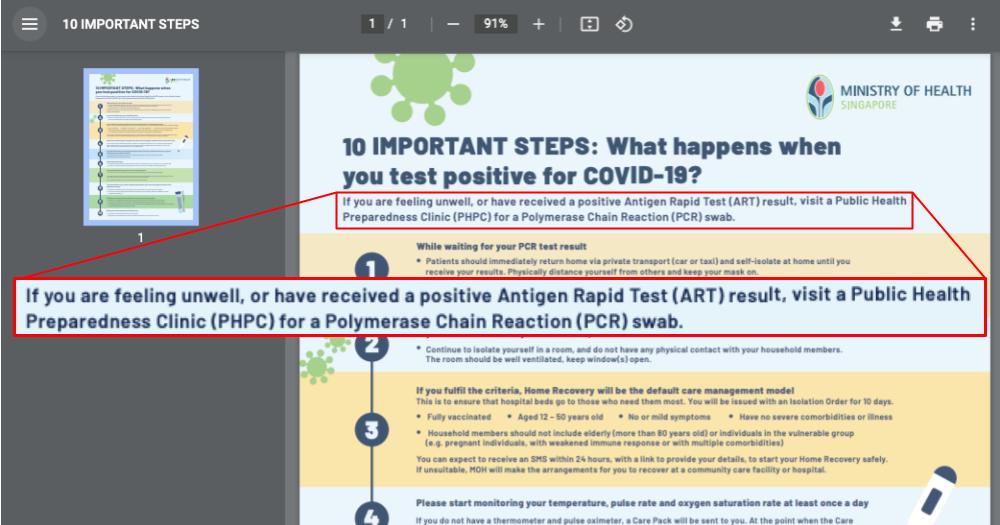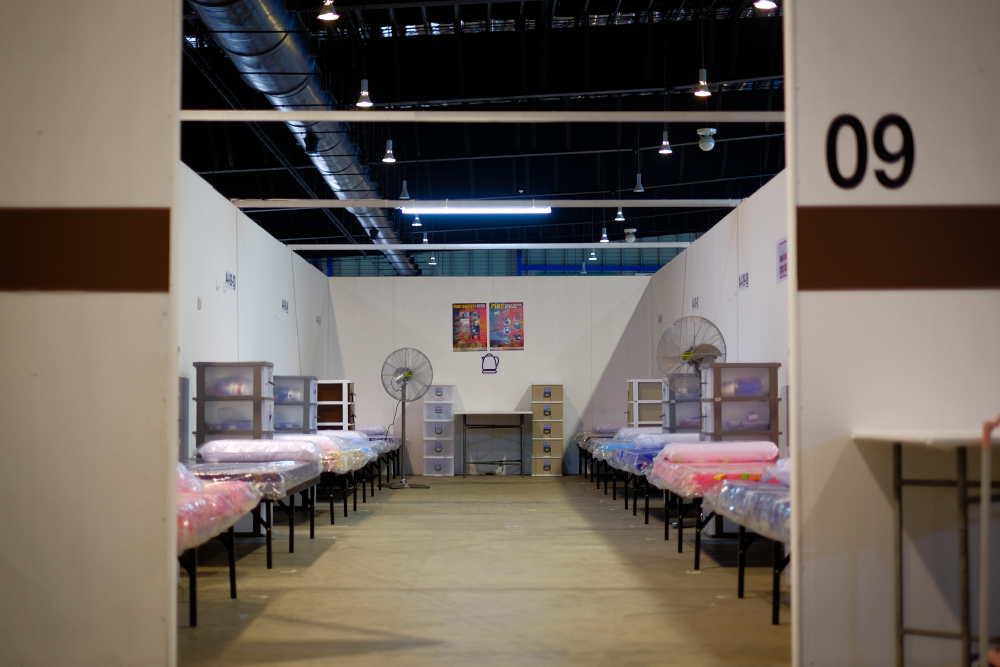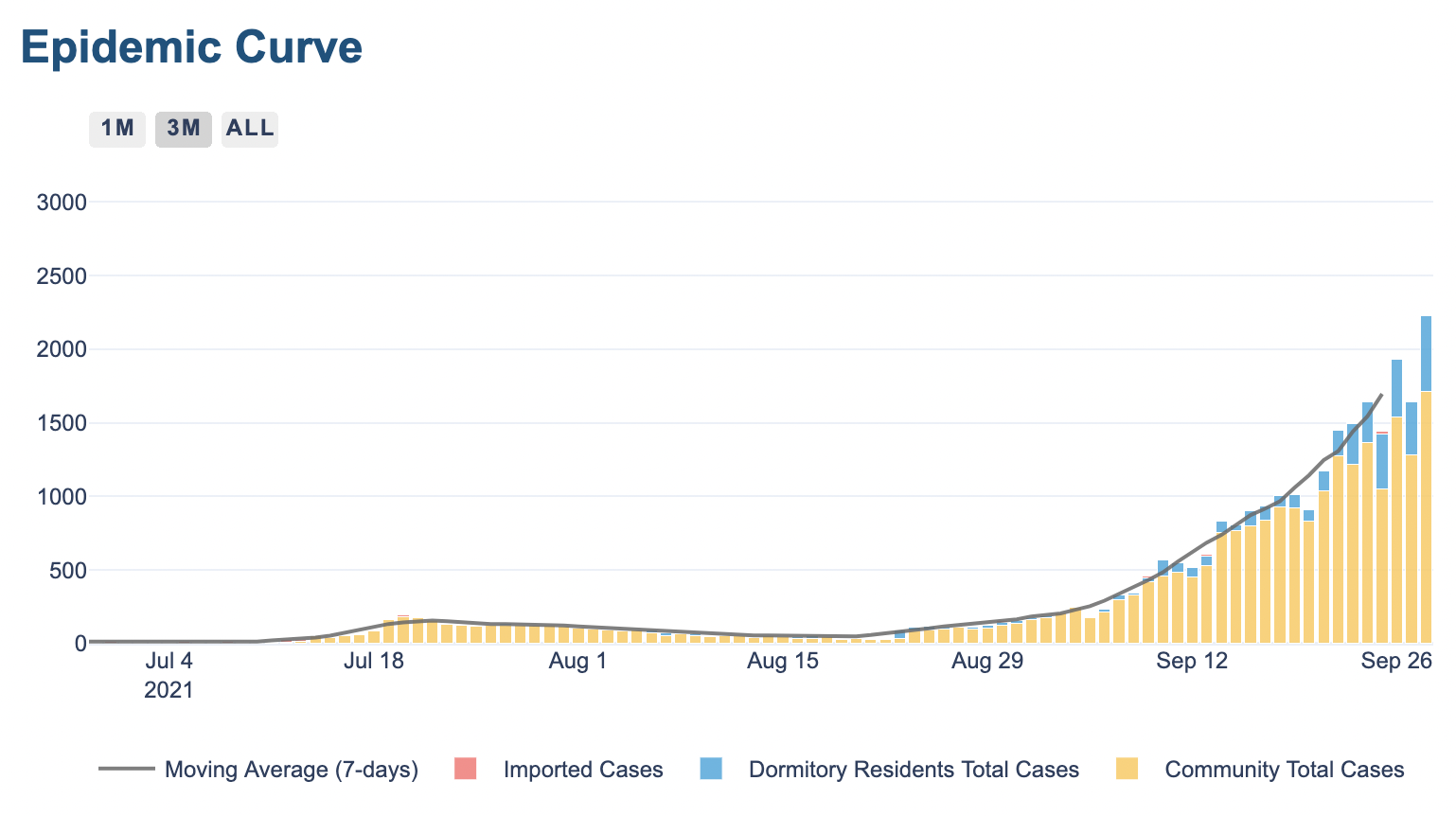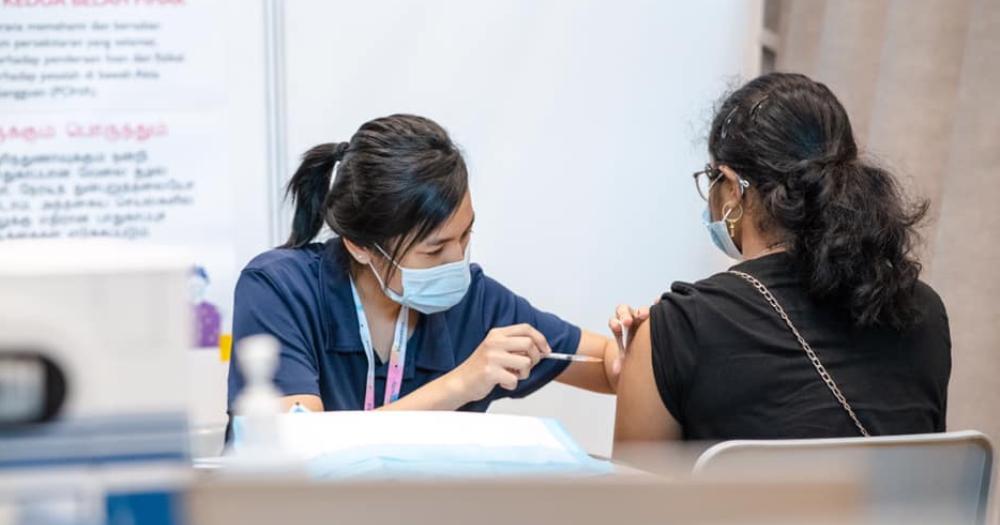Follow us on Telegram for the latest updates: https://t.me/mothershipsg
It's to be expected that Singapore's Covid-19 response would evolve over time, as we learnt more about the virus that has plagued us (and the world) for nearly two years.
But there's something different about the most recent changes to our somewhat-settled "new normal norms": They changed too much, and changed too fast.
The changes, which are to support Singapore's transition to living with Covid-19 as an endemic disease, require not just compliance, but understanding.
As a result, at first glance, certain aspects of the new procedures might not seem to make sense.
Two of the most significant new procedures are:
Home recovery as the default, under the Ministry of Health (MOH)'s Home Recovery Programme (HRP) which was announced on Sep. 10, 2021 after a successful pilot scheme.
- 72-hour self-isolation for those who test positive via a self-administered Antigen Rapid Test (ART), with no requirement to go for further testing or inform MOH — provided that the person who tested positive is asymptomatic, among other criteria.
These new procedures are significantly different from the initial procedure for Covid-19 positive cases, all of whom were warded, or isolated in dedicated facilities, while their close contacts were quarantined — often in Government Quarantine Facilities (GQFs) as well.
But wait a minute, the idea of home recovery isn't new at all.
Didn't Prime Minister Lee Hsien Loong talk about a new normal, including home recovery, as early as May 2021, while laying out a morale-boosting vision for Singapore in a televised address watched by several hundred thousand people?
Indeed, home recovery was mentioned much earlier than that — as early as Feb. 2020, as an example of how Singapore might deal with Covid-19 if it became widespread.
Home recovery in 2021 is quite different, as we are now highly-vaccinated, something quite unimaginable back in Feb. 2020, in the very early stages.
The logic has not changed, however: Home recovery conserves our limited hospital capacity for those who need it most, since most of us are not likely to have serious illness, if infected.
But although the general idea makes sense, our struggle to understand these new processes might come from the fact that some specific aspects look like almost 180° turnarounds from just months ago.
Here are some examples:
1. Is an ensuite toilet needed for isolation at home?
Previously, those returning from high-risk countries could choose to serve their mandatory Stay Home Notice (SHN) at home.
To do so, they would need to have a room with an ensuite toilet.
If this could not be arranged, MOH would see to it that these suspect cases were completely isolated by moving them to a GQF.
Now, however, home recovery is allowed even without an ensuite toilet (which is "preferred", rather than "required"), and positive cases can move around in their house with just a mask on.
Why is an actually-positive case seemingly treated with less caution than a suspect case, you might ask.
One difference lies in the fact that if a suspect case is on SHN at home, their family members are still allowed to go about their normal routines.
On the other hand, household members of someone recovering from Covid-19 at home would all be required to quarantine till the person has recovered.
Also, home recovery is restricted to those who have mild symptoms, which means a lower probability of them spreading the virus. It is also not available to those who live with someone from a vulnerable group (e.g. those who are immunocompromised), which reduces the risk of serious illness from any inadvertent transmission.
2. Does someone with a positive ART need to get a PCR test?
MOH has also changed its guidance for those who have a positive ART result.
BEFORE
While ART tests gave much quicker results, they were said to have only "fairly accurate" results as compared to PCR tests, which are the "gold standard" for Covid-19 detection.
As such, it was understood that those who tested positive through ARTs should follow the "standard procedure" of confirming positive ART results.
NOW
Now, however, not everyone who tests positive via an ART needs a confirmatory PCR test — according to updates from MOH.
Instead, those who do a self-ART and get positive results can choose to self-isolate for 72 hours before testing themselves again, if they are asymptomatic.
This was announced by Kenneth Mak, MOH's Director of Medical Services, in a press conference on Sep. 18, 2021.
This is apparently the new standard procedure, according to an updated version of MOH's FAQs on Sep. 25, 2021, which gives further details on who needs a PCR and who doesn't.
The "new regime of self-isolation", as Mak called it, may make sense as it helps conserve limited healthcare resources, while allowing asymptomatic individuals to move on with life much more quickly and easily.
But more could have been said about the new regime and its implications, however, since it marked such a drastic departure from the previous policy.
And, MOH could perhaps have acknowledged more prominently that it was changing its previous policy, which had actually been restated as recently as Sep. 14, 2021, in a 10-step infographic published on the MOH website as an annex to a news release.
 An apparently-outmoded 10-step infographic published by MOH on Sep. 14, 2021. Screenshot via MOH website.
An apparently-outmoded 10-step infographic published by MOH on Sep. 14, 2021. Screenshot via MOH website.
3. Does someone self-isolating after a positive self-ART need contact tracing?
Another implication of the self-isolation regime is that positive cases will no longer have their close contacts traced.
BEFORE
Previously, all close contacts of positive case would be tracked down and quarantined, so infections could be ringfenced.
To ensure that this was as watertight as possible, positive cases would have to disclose details of their schedule and whereabouts to contact tracers, on pain of imprisonment if they did not do so honestly.
National contact tracing programmes (SafeEntry and TraceTogether) were also pushed out, to augment this.
NOW
With the self-isolation regime for positive ART cases, however, your positive ART results do not even need to be reported to MOH.
And as for informing your close contacts? You will have do your own personal contact tracing.
TraceTogether won't help you, so you can't inform the stranger who sat one metre away from you in the cinema for three hours while you both snacked on popcorn.
Your known close contacts — such as friends or family members — will not receive any special help with getting tested for their peace of mind.
They could, however, perform self-ARTs with government-provided kits, or with kits purchased at their own expense.
This stands in stark contrast to how, just months ago in Jun. and Jul. 2021, extensive testing operations were carried out for entire HDB blocks and neighbourhoods when positive cases were identified in the area.
Such targeted testing is arguably less important now, with more of us vaccinated. Also, it is less and less feasible as the number of cases continues to rise.
Thus, moving forward, peace of mind will cost around S$10 from a supermarket or pharmacy — unless you happen to get some free kits, perhaps from your employer?
4. When should Covid-19 patients be discharged?
The self-isolation regime, as well as HRP, allow for Covid-19 patients to be discharged much more quickly than before — as quickly as 72 hours.
BEFORE
Previously, Covid-19 patients were kept in hospitals or Community Care Facilities for weeks — sometimes months.
This was due to the requirement that patients should test negative twice consecutively before they could be discharged, even for those who were clinically well.
NOW
Now, those on HRP could be discharged after 10 days without even needing an exit PCR test.
They will not receive a certificate that they are "clear" of Covid-19.
If you find the contrast to be stark, however, it could be due to how we have forgotten that over time, the policies for discharging Covid-19 patients changed as we learnt more about the recovery process.
In May 2020, 18 patients were discharged from a CCF despite "persistently" testing positive, as MOH found them to be shedding dead components of the virus.
One of them stayed at the CCF for a whopping 56 days.
Nowadays, according to MOH, vaccinated individuals are extremely unlikely to be infectious after 10 days.
Again, this could be an example of a new Covid-19 policy which makes sense, but may leave people feeling uncertain because it is so different from before.
Some questions have yet to be clarified
While the above examples could be rationalised by referring back to previous explanations, as well as MOH's more recent updates, there are still some questions about how Singapore is currently handling Covid-19 which have yet to be clarified.
1. Is it time to bring back large-scale CCFs?
The tightened measures that kicked in earlier this week were said to be necessary because the healthcare system needed time to build up extra capacity.
Last year, massive CCFs with thousands of beds were set up in locations like D'Resort @ Downtown East, Singapore Expo, Changi Exhibition Centre, Big Box in Jurong, Tanjong Pagar Terminal, NUS Prince George’s Park Residences, as well as Singapore Armed Forces camps.
 Photo by Rexanne Yap.
Photo by Rexanne Yap.
They housed thousands of positive cases in 2020, and were eventually closed when the Covid-19 situation was more controlled.
Is it time to reactivate them to boost our hospital capacity?
2. What is the difference between a PCR and ART test?
Why do positive results from PCR tests seem to be more "real", and treated more seriously?
Those with positive PCR test results cannot opt for home recovery if they have elderly or immunocompromised family members.
This is the case even if they are asymptomatic.
However, those on the self-isolation regime after a positive ART result are allowed to self-isolate at home regardless of who they live with.
3. How much contact tracing are we doing?
Those on the self-isolation regime after a positive ART result do not need to report to MOH or get more tests, if they are asymptomatic. And by extension, their close contacts will not be traced.
But what about those who are quarantined, or have a Health Risk Warning, who are required to report their ART results online?
What happens when someone on quarantine gets a positive ART?
The terms of use of the Covid-19 Self Testing Portal say that data provided may be used for contact tracing, among other purposes.
 Part of the terms of use of the Covid-19 Self Testing Portal.
Part of the terms of use of the Covid-19 Self Testing Portal.
But will contact tracing be done?
If it is, then why the different treatment between the close contacts of those who are ART positive while on QO or HRW, and the close contacts of those who test positive on their own via ART?
Or, will those on QO or HRW also be allowed to opt for the 72-hour self-isolation regime, like the rest of us?
4. Home recovery and ART-positive self-isolation makes sense. But what about those who need boosters?
Singapore has started giving booster shots to those who are expected to have weaker immunity, starting with seniors.
Boosters will soon be given to those above 50.
But most seniors below 70, even if they have not gotten booster shots, are allowed to recover at home, provided they have no underlying conditions (or, comorbidities).
Should these seniors receive hospital care if they test positive, on account of their weaker immunity?
Also, if someone in their household tests positive, should these unboosted 50+ year olds be living in the same house while their Covid-positive family members are recovering?
For now, the answer is unclear, though seniors in such situations could find temporary accommodation elsewhere to be extra safe — at their own expense.
Actually, how did we get here? Why did things change so quickly?
On Sep. 17, health minister Ong Ye Kung warned that cases might hit the 1,000 mark, and said that the current wave was ongoing for 26 days.
This means the wave started on Aug. 22. Tracing back, the incubation period for the Delta variant of Covid-19 is taken to be closer to 10, rather than 14 days.
This means that the current wave of infections was likely seeded approximately 10 days before Aug. 22, around early to mid-August — this happens to be when Phase 2 (Heightened Alert) restrictions were eased on Aug. 10.
Then, there were still over a hundred cases each day, and numbers were falling, even though vaccination rates were indeed on target.
 Screenshot from MOH's Covid-19 situation report.
Screenshot from MOH's Covid-19 situation report.
This raises the question: Did Singapore ease P2HA restrictions too early? Could the current wave have been prevented, or better controlled, if P2HA had been kept in place till Aug. 18, as initially planned?
Either way, Singapore will have to deal with its high number of infections now.
What's next?
Multi-ministry Task Force (MTF) co-chair Lawrence Wong has said that Singapore is preparing for 5,000 daily cases.
But what comes after we are prepared?
If measures are loosened, will our capacity to deal with 5,000 cases then need to be expanded again to be able to deal with 10,000?
A review of the Covid-19 situation and the current restrictions is expected in about a week.
Hopefully, more clarity
Hopefully, people in Singapore will have more clarity on the MTF's overall Covid-19 strategy.
As the above examples show, clearer communication is needed — especially for what happens when a self-ART turns out positive, and for home recovery.
The concept of recovering at home may not be new, but the specific procedures are relatively new in terms of their implementation.
They involve complicated scenarios due to different households having different arrangements, and thus, the implications and uncertainties that come along are quite significant.
But when the self-isolation regime for ART-positive individuals was introduced, it was not even signposted as a shift from the previous norm of ART-positive individuals getting a confirmatory PCR test.
Instead, it was announced as if it had always been the case.
Clarity protects people in Singapore, and the healthcare system, from being overwhelmed
An overwhelmed healthcare system is surely something to be avoided at all costs.
In the same way, people in Singapore need to be kept from getting overwhelmed too.
This is because overwhelmed people will go on to overwhelm the healthcare system, as we saw in the past week.
Amid news of increasing crowds at hospitals' emergency departments, Mak told The Straits Times that many who were actually well had likely ended up going to the hospital as they were worried and unsure of what to do.
"And a lot of people are actually very anxious," Mak noted.
Maybe what we need is another televised address.
Related story:
Top photo credit: MOE, via Ong Ye Kung on Facebook
Follow and listen to our podcast here
If you like what you read, follow us on Facebook, Instagram, Twitter and Telegram to get the latest updates.
